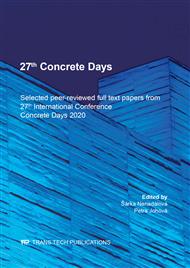[1]
F.P. Glasser, J. Marchand, E. Samson, Durability of concrete — Degradation phenomena involving detrimental chemical reactions, Cem Concr Res. 38(2) (2008) 226–46.
DOI: 10.1016/j.cemconres.2007.09.015
Google Scholar
[2]
H. Wiggenhauser, C. Köpp, J. Timofeev, H. Azari, Controlled Creating of Cracks in Concrete for Non-destructive Testing, J Nondestruct Eval. 37(3) (2018) 67.
DOI: 10.1007/s10921-018-0517-x
Google Scholar
[3]
J.F. Lataste, C. Sirieix, D. Breysse, M. Frappa, Electrical resistivity measurement applied to cracking assessment on reinforced concrete structures in civil engineering, NDT E Int. 36(6) (2003) 383–94.
DOI: 10.1016/s0963-8695(03)00013-6
Google Scholar
[4]
M. Brigante, M.A. Sumbatyan, Acoustic methods for the nondestructive testing of concrete: A review of foreign publications in the experimental field, Russ J Nondestruct Test. 49(2) (2013) 100–11.
DOI: 10.1134/s1061830913020034
Google Scholar
[5]
J. Tashan, R. Al-Mahaidi, Detection of cracks in concrete strengthened with CFRP systems using infra-red thermography, Compos Part B Eng. 64 (2014) 116–25.
DOI: 10.1016/j.compositesb.2014.04.011
Google Scholar
[6]
A. Mazzoli, S. Monosi, E.S. Plescia, Evaluation of the early-age-shrinkage of Fiber Reinforced Concrete (FRC) using image analysis methods, Constr Build Mater. 101 (2015) 596–601.
DOI: 10.1016/j.conbuildmat.2015.10.090
Google Scholar
[7]
S. Erdem, S. Hanbay, M.A. Blankson, Self-sensing damage assessment and image-based surface crack quantification of carbon nanofibre reinforced concrete, Constr Build Mater. 134 (2017) 520–9.
DOI: 10.1016/j.conbuildmat.2016.12.197
Google Scholar
[8]
M.K. Kim, D.J. Kim, Y.K. An, Electro-mechanical self-sensing response of ultra-high-performance fiber-reinforced concrete in tension, Compos Part B Eng. 134 (2018) 254–64.
DOI: 10.1016/j.compositesb.2017.09.061
Google Scholar
[9]
T. Chandra Sekhara Reddy, A. Ravitheja, Macro mechanical properties of self healing concrete with crystalline admixture under different environments, Ain Shams Eng J. 10(1) (2019) 23–32.
DOI: 10.1016/j.asej.2018.01.005
Google Scholar
[10]
K. Van Tittelboom, J. Wang, M. Araújo, D. Snoeck, E. Gruyaert, B. Debbaut, et al., Comparison of different approaches for self-healing concrete in a large-scale lab test, Constr Build Mater. 107 (2016) 125–37.
DOI: 10.1016/j.conbuildmat.2015.12.186
Google Scholar
[11]
H.X.D. Lee, H.S. Wong, N.R. Buenfeld, Self-sealing of cracks in concrete using superabsorbent polymers, Cem Concr Res. 79 (2016) 194–208.
DOI: 10.1016/j.cemconres.2015.09.008
Google Scholar
[12]
S. Kim, D.Y. Yoo, M.J. Kim, N. Banthia, Self-healing capability of ultra-high-performance fiber-reinforced concrete after exposure to cryogenic temperature, Cem Concr Compos. 104 (2019) 103335.
DOI: 10.1016/j.cemconcomp.2019.103335
Google Scholar
[13]
H. Singh, R. Gupta, Influence of cellulose fiber addition on self-healing and water permeability of concrete, Case Stud Constr Mater. 12 (2020) e00324.
DOI: 10.1016/j.cscm.2019.e00324
Google Scholar
[14]
E. Tziviloglou, V. Wiktor, H.M. Jonkers, E. Schlangen, Bacteria-based self-healing concrete to increase liquid tightness of cracks, Constr Build Mater. 122 (2016) 118–25.
DOI: 10.1016/j.conbuildmat.2016.06.080
Google Scholar
[15]
M.G. Sierra-Beltran, H.M. Jonkers, E. Schlangen, Characterization of sustainable bio-based mortar for concrete repair, Constr Build Mater. 67(PART C) (2014) 344–52.
DOI: 10.1016/j.conbuildmat.2014.01.012
Google Scholar
[16]
H. Jonkers, E. Schlangen, Development of a bacteria-based self healing concrete, Tailor Made Concr Struct. (December) (2008) 109–109.
DOI: 10.1201/9781439828410.ch72
Google Scholar
[17]
J.A. Bogas, A. Carriço, J. Pontes, Influence of cracking on the capillary absorption and carbonation of structural lightweight aggregate concrete, Cem Concr Compos. 104 (2019) 103382.
DOI: 10.1016/j.cemconcomp.2019.103382
Google Scholar
[18]
N.P. Kaur, S. Majhi, N.K. Dhami, A. Mukherjee, Healing fine cracks in concrete with bacterial cement for an advanced non-destructive monitoring, Constr Build Mater. 242 (2020) 118151.
DOI: 10.1016/j.conbuildmat.2020.118151
Google Scholar
[19]
Y.C. Erşan, E. Gruyaert, G. Louis, C. Lors, N. De Belie, N. Boon, Self-protected nitrate reducing culture for intrinsic repair of concrete cracks, Front Microbiol. 6 (2015) 1228.
DOI: 10.3389/fmicb.2015.01228
Google Scholar
[20]
J. Xu, W. Yao, Multiscale mechanical quantification of self-healing concrete incorporating non-ureolytic bacteria-based healing agent, Cem Concr Res. 64 (2014) 1–10.
DOI: 10.1016/j.cemconres.2014.06.003
Google Scholar
[21]
M. Luo, C.X. Qian, R.Y. Li, Factors affecting crack repairing capacity of bacteria-based self-healing concrete, Constr Build Mater. 87 (2015) 1–7.
DOI: 10.1016/j.conbuildmat.2015.03.117
Google Scholar
[22]
Y.C. Erşan, D. Palin, H. Jonkers, N. Boon, N. Belie, Healing Depth and Functionality Regain of Non-Axenic Granulated Culture Based Self-Healing Concrete In: Microorganisms-Cementitious Materials Interactions, 25-26 June 2018, Toulouse. 2018. p.1–12.
Google Scholar
[23]
V. Wiktor, H.M. Jonkers, Quantification of crack-healing in novel bacteria-based self-healing concrete, Cem Concr Compos. 33(7) (2011) 763–70.
DOI: 10.1016/j.cemconcomp.2011.03.012
Google Scholar
[24]
Z. Lyu, A. Shen, S. Mo, Z. Chen, Z. He, D. Li, et al., Life-cycle crack resistance and micro characteristics of internally cured concrete with superabsorbent polymers, Constr Build Mater. 259 (2020) 119794.
DOI: 10.1016/j.conbuildmat.2020.119794
Google Scholar


